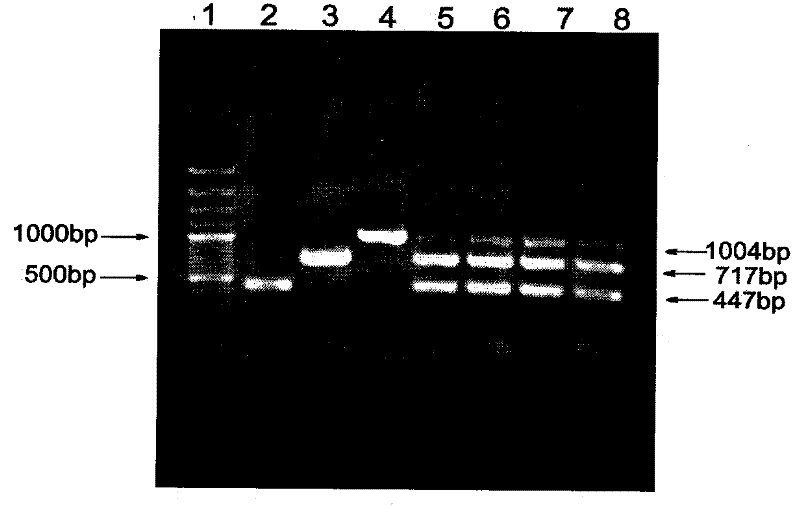Method for detecting Francisella tularensis using multiple PCR technology
A kind of technical detection, Tura technology, applied in the direction of biochemical equipment and methods, microbial determination/inspection, etc., can solve the problems of inability to meet rapid detection, long detection time, low sensitivity, etc.
- Summary
- Abstract
- Description
- Claims
- Application Information
AI Technical Summary
Problems solved by technology
Method used
Image
Examples
Embodiment 1
[0069] Embodiment 1: PCR detection of Francisella tularensis in soil
[0070] 1. Sample pretreatment
[0071] Two soil samples (1g / part) were collected and added to 30mL TSB medium, one of which was inoculated with a single colony of Francisella tularensis F001, and cultured at 200rpm / min at 37°C for 6 hours for pre-enrichment. After enrichment, let it stand, and after the soil sample was precipitated, take 1 μL of the bacterial suspension as a bacterial template for multiplex PCR detection.
[0072] 2. PCR reaction
[0073] PCR reaction system
[0074] Reaction system (20μL):
[0075] 10×PCR Buffer: 2μL,
[0076] d NTP: 2 μL,
[0077] Template: 1 μL,
[0078] Taq enzyme: 0.1 μL,
[0079] Primers: lpxE(+) 0.5 μL, lpxE(-) 0.5 μL,
[0080] lpxF(+) 0.5 μL, lpxF(+) 0.5 μL,
[0081] flmK(+) 1.5 μL, flmK(-) 1.5 μL,
[0082] wxya 2 O: Make up 20 μL.
[0083] PCR reaction process
[0084] The multiplex PCR amplification program and the melting temperature program for...
Embodiment 2
[0093] Embodiment 2: PCR detection of Francisella tulara in water
[0094] 1. Sample pretreatment
[0095]Two water samples (5 mL / part) were collected and 30 mL of TSB medium was added, one of which was inoculated with a single colony of Francisella tularensis F001, and cultured at 200 rpm / min at 37°C for 6 hours for pre-enrichment. After enrichment, 1 μL of the bacterial suspension was used as a bacterial template for multiplex PCR detection.
[0096] 2. PCR reaction: the reaction conditions and system are the same as in Example 1.
[0097] 3. Test results and description
[0098] Analyzed by 1% agarose gel electrophoresis, the results are shown in the appendix Figure 5 .
[0099] The results showed that the corresponding specific bands were amplified in the water samples added with bacteria (see attached Figure 5 4th track), and no corresponding bands appeared in the samples without artificial bacteria addition (see attached Figure 5 track 5).
Embodiment 3
[0100] Embodiment 3: the PCR detection of Francisella tularensis in the air
[0101] 1. Sample pretreatment
[0102] Two samples of dust in the air (1 g / part) were collected with a vacuum cleaner, and 30 mL of TSB medium was added, one of which was inoculated with a single colony of Francisella tularensis F001, cultured at 37°C, 200 rpm / min for 6 hours for pre-enrichment. After enrichment, 1 μl of the bacterial suspension was used as a template for multiplex PCR detection.
[0103] 2. PCR reaction: the reaction conditions and reaction system are the same as in Example 1.
[0104] 3. Test results and description
[0105] Analyzed by 1% agarose gel electrophoresis. The results showed that the corresponding specific bands were amplified in the samples added with bacteria (see the results in the attached Figure 5 6th track), and no corresponding bands appeared in the samples without artificial addition of bacteria (see attached Figure 5 track 7).
PUM
 Login to View More
Login to View More Abstract
Description
Claims
Application Information
 Login to View More
Login to View More - R&D
- Intellectual Property
- Life Sciences
- Materials
- Tech Scout
- Unparalleled Data Quality
- Higher Quality Content
- 60% Fewer Hallucinations
Browse by: Latest US Patents, China's latest patents, Technical Efficacy Thesaurus, Application Domain, Technology Topic, Popular Technical Reports.
© 2025 PatSnap. All rights reserved.Legal|Privacy policy|Modern Slavery Act Transparency Statement|Sitemap|About US| Contact US: help@patsnap.com



